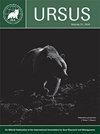Primarily resident grizzly bears respond to late-season elk harvest
IF 0.6
4区 生物学
Q4 ZOOLOGY
引用次数: 1
Abstract
Abstract: Autumn ungulate hunting in the Greater Yellowstone Ecosystem carries the risk of hunter–grizzly bear (Ursus arctos) conflict and creates a substantial challenge for managers. For Grand Teton National Park, Wyoming, USA, a key information need is whether increased availability of elk (Cervus canadensis) carcasses during a late autumn (Nov–Dec) harvest within the national park attracts grizzly bears and increases the potential for conflict with hunters. Using a robust design analysis with 6 primary sampling periods during 2014–2015, we tested the hypothesis that the elk harvest resulted in temporary movements of grizzly bears into the hunt areas, thus increasing bear numbers. We detected 31 unique individuals (6 F, 25 M) through genetic sampling and retained 26 encounter histories for analysis. Markovian movement models had more support than a null model of no temporary movement. Contrary to our research hypothesis, temporary movements into the study area occurred between the July–August (no hunt; N̄2014–2015 = 5) and September–October (no hunt; N̄2014–2015 = 24) primary periods each year, rather than during the transition from September–October (no hunt) to November–December (hunt; N̄2014–2015 = 15). A post hoc analysis indicated that September–October population estimates were biased high by detections of transient bears. Grizzly bear presence during the elk hunt was limited to approximately 15 resident bears that specialized in accessing elk carcasses. The late timing of the elk hunt likely moderated the effect of carcasses as a food attractant because it coincides with the onset of hibernation. From a population response perspective, the current timing of the elk harvest likely represents a scenario of low relative risk of hunter–bear conflicts. The risk of hunter–grizzly bear encounters remains, but may be more a function of factors that operate at the level of individual bears and hunters, such as hunter movements and bear responses to olfactory cues.主要是居住的灰熊对晚季麋鹿的收获做出了反应
摘要:在大黄石生态系统中,秋季有蹄类动物的狩猎存在着猎人与灰熊(Ursus arctos)冲突的风险,给管理者带来了巨大的挑战。对于美国怀俄明州的大提顿国家公园来说,一个关键的信息需求是,在深秋(11 - 12月)收获期间,国家公园内麋鹿(Cervus canadensis)尸体的增加是否会吸引灰熊,并增加与猎人冲突的可能性。利用2014-2015年6个主要采样期的稳健设计分析,我们验证了麋鹿的收获导致灰熊暂时迁移到狩猎区域,从而增加熊数量的假设。我们通过基因取样检测到31个独特的个体(6个F, 25个M),并保留了26个相遇史用于分析。马尔可夫运动模型比没有临时运动的零模型更有支持。与我们的研究假设相反,进入研究区域的临时活动发生在7月至8月之间(没有狩猎;2014年- 2015年= 5)和9月- 10月(没有狩猎;N ā 2014-2015 = 24)每年的主要时期,而不是从9 - 10月(不狩猎)到11 - 12月(狩猎;N(2014-2015) = 15)。一项事后分析表明,9月至10月的种群数量估计因检测到临时熊而有很大偏差。在猎杀麋鹿期间,灰熊的存在仅限于大约15只专门捕食麋鹿尸体的熊。麋鹿狩猎的时间较晚,可能会缓和尸体作为食物引诱剂的作用,因为它与冬眠的开始相吻合。从种群反应的角度来看,目前麋鹿收获的时间可能代表了猎熊冲突相对风险较低的情况。猎人与灰熊相遇的风险仍然存在,但可能更多的是在个体熊和猎人的层面上起作用的因素,比如猎人的动作和熊对嗅觉线索的反应。
本文章由计算机程序翻译,如有差异,请以英文原文为准。
求助全文
约1分钟内获得全文
求助全文
来源期刊

Ursus
生物-动物学
CiteScore
2.00
自引率
15.40%
发文量
12
审稿时长
>12 weeks
期刊介绍:
Ursus includes a variety of articles on all aspects of bear management and research worldwide. Original manuscripts are welcome. In addition to manuscripts reporting original research, submissions may be based on thoughtful review and synthesis of previously-reported information, innovative philosophies and opinions, and public policy or legal aspects of wildlife conservation. Notes of general interest are also welcome. Invited manuscripts will be clearly identified, but will still be subject to peer review. All manuscripts must be in English. All manuscripts are peer-reviewed, and subject to rigorous editorial standards.
 求助内容:
求助内容: 应助结果提醒方式:
应助结果提醒方式:


